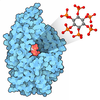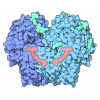+ Open data
Open data
- Basic information
Basic information
| Entry | Database: PDB / ID: 9bhx | ||||||
|---|---|---|---|---|---|---|---|
| Title | Structure of the extracellular domain of Protein Sevenless | ||||||
 Components Components | Protein sevenless | ||||||
 Keywords Keywords | SIGNALING PROTEIN / receptor tyrosine kinase / ROS1 | ||||||
| Function / homology |  Function and homology information Function and homology informationgerm-line stem-cell niche homeostasis / transmembrane receptor protein kinase activity / R7 cell fate commitment / sevenless signaling pathway / regulation of TOR signaling / transmembrane receptor protein tyrosine kinase activity / visual perception / cell surface receptor protein tyrosine kinase signaling pathway / placental growth factor receptor activity / insulin receptor activity ...germ-line stem-cell niche homeostasis / transmembrane receptor protein kinase activity / R7 cell fate commitment / sevenless signaling pathway / regulation of TOR signaling / transmembrane receptor protein tyrosine kinase activity / visual perception / cell surface receptor protein tyrosine kinase signaling pathway / placental growth factor receptor activity / insulin receptor activity / hepatocyte growth factor receptor activity / macrophage colony-stimulating factor receptor activity / platelet-derived growth factor alpha-receptor activity / platelet-derived growth factor beta-receptor activity / stem cell factor receptor activity / boss receptor activity / protein tyrosine kinase collagen receptor activity / brain-derived neurotrophic factor receptor activity / transmembrane-ephrin receptor activity / GPI-linked ephrin receptor activity / epidermal growth factor receptor activity / fibroblast growth factor receptor activity / insulin-like growth factor receptor activity / receptor protein-tyrosine kinase / receptor complex / ATP binding / plasma membrane Similarity search - Function | ||||||
| Biological species |  | ||||||
| Method | ELECTRON MICROSCOPY / single particle reconstruction / cryo EM / Resolution: 3.94 Å | ||||||
 Authors Authors | Zhang, J. / Klein, D.E. | ||||||
| Funding support | 1items
| ||||||
 Citation Citation |  Journal: Nat Commun / Year: 2025 Journal: Nat Commun / Year: 2025Title: Structural basis for the interaction between the Drosophila RTK Sevenless (dROS1) and the GPCR BOSS. Authors: Jianan Zhang / Yuko Tsutsui / Hengyi Li / Tongqing Li / Yueyue Wang / Salma Laraki / Sofia Alarcon-Frias / Steven E Stayrook / Daryl E Klein /  Abstract: Sevenless, the Drosophila homologue of ROS1 (University of Rochester Sarcoma) (herein, dROS1) is a receptor tyrosine kinase (RTK) essential for the differentiation of Drosophila R7 photoreceptor ...Sevenless, the Drosophila homologue of ROS1 (University of Rochester Sarcoma) (herein, dROS1) is a receptor tyrosine kinase (RTK) essential for the differentiation of Drosophila R7 photoreceptor cells. Activation of dROS1 is mediated by binding to the extracellular region (ECR) of the GPCR (G protein coupled receptor) BOSS (Bride Of Sevenless) on adjacent cells. Activation of dROS1 by BOSS leads to subsequent downstream signaling pathways including SOS (Son of Sevenless). However, the physical basis for how dROS1 interacts with BOSS has long remained unknown. Here we provide a cryo-EM structure of dROS1's extracellular region, which mediates ligand binding. We show that the extracellular region of dROS1 adopts a folded-over conformation stabilized by an N-terminal domain comprised of two disulfide stapled helical hairpins. We further narrowed down the interacting binding epitopes on both dROS1 and BOSS using hydrogen-deuterium exchange mass spectrometry (HDX-MS). This includes beta-strands in dROS1's third Fibronectin type III (FNIII) domain and a C-terminal peptide in BOSS' ECR. Our mutagenesis studies, coupled with AlphaFold complex predictions, support a binding interaction mediated by a hydrophobic interaction and beta-strand augmentation between these regions. Our findings provide a fundamental understanding of the regulatory function of dROS1 and further provide mechanistic insight into the human ortholog and oncogene ROS1. | ||||||
| History |
|
- Structure visualization
Structure visualization
| Structure viewer | Molecule:  Molmil Molmil Jmol/JSmol Jmol/JSmol |
|---|
- Downloads & links
Downloads & links
- Download
Download
| PDBx/mmCIF format |  9bhx.cif.gz 9bhx.cif.gz | 211.9 KB | Display |  PDBx/mmCIF format PDBx/mmCIF format |
|---|---|---|---|---|
| PDB format |  pdb9bhx.ent.gz pdb9bhx.ent.gz | 157.1 KB | Display |  PDB format PDB format |
| PDBx/mmJSON format |  9bhx.json.gz 9bhx.json.gz | Tree view |  PDBx/mmJSON format PDBx/mmJSON format | |
| Others |  Other downloads Other downloads |
-Validation report
| Arichive directory |  https://data.pdbj.org/pub/pdb/validation_reports/bh/9bhx https://data.pdbj.org/pub/pdb/validation_reports/bh/9bhx ftp://data.pdbj.org/pub/pdb/validation_reports/bh/9bhx ftp://data.pdbj.org/pub/pdb/validation_reports/bh/9bhx | HTTPS FTP |
|---|
-Related structure data
| Related structure data |  44556MC M: map data used to model this data C: citing same article ( |
|---|---|
| Similar structure data | Similarity search - Function & homology  F&H Search F&H Search |
- Links
Links
- Assembly
Assembly
| Deposited unit | 
|
|---|---|
| 1 |
|
- Components
Components
| #1: Protein | Mass: 181029.219 Da / Num. of mol.: 1 Source method: isolated from a genetically manipulated source Source: (gene. exp.)   Trichoplusia ni (cabbage looper) Trichoplusia ni (cabbage looper)References: UniProt: P13368, receptor protein-tyrosine kinase |
|---|---|
| Has protein modification | Y |
-Experimental details
-Experiment
| Experiment | Method: ELECTRON MICROSCOPY |
|---|---|
| EM experiment | Aggregation state: PARTICLE / 3D reconstruction method: single particle reconstruction |
- Sample preparation
Sample preparation
| Component | Name: Protein sevenless / Type: CELL / Details: Monomeric / Entity ID: all / Source: NATURAL | |||||||||||||||
|---|---|---|---|---|---|---|---|---|---|---|---|---|---|---|---|---|
| Source (natural) | Organism:  | |||||||||||||||
| Buffer solution | pH: 7.5 | |||||||||||||||
| Buffer component |
| |||||||||||||||
| Specimen | Embedding applied: NO / Shadowing applied: NO / Staining applied: NO / Vitrification applied: YES | |||||||||||||||
| Specimen support | Grid material: COPPER / Grid mesh size: 300 divisions/in. / Grid type: Quantifoil R1.2/1.3 | |||||||||||||||
| Vitrification | Instrument: FEI VITROBOT MARK IV / Cryogen name: ETHANE / Humidity: 100 % / Chamber temperature: 289.15 K |
- Electron microscopy imaging
Electron microscopy imaging
| Experimental equipment |  Model: Titan Krios / Image courtesy: FEI Company |
|---|---|
| Microscopy | Model: FEI TITAN KRIOS |
| Electron gun | Electron source:  FIELD EMISSION GUN / Accelerating voltage: 300 kV / Illumination mode: FLOOD BEAM FIELD EMISSION GUN / Accelerating voltage: 300 kV / Illumination mode: FLOOD BEAM |
| Electron lens | Mode: BRIGHT FIELD / Nominal defocus max: 2600 nm / Nominal defocus min: 1800 nm / Cs: 2.7 mm / C2 aperture diameter: 50 µm |
| Image recording | Electron dose: 50.56 e/Å2 / Film or detector model: GATAN K3 (6k x 4k) |
- Processing
Processing
| EM software | Name: PHENIX / Version: 1.20.1_4487: / Category: model refinement | ||||||||||||||||||||||||
|---|---|---|---|---|---|---|---|---|---|---|---|---|---|---|---|---|---|---|---|---|---|---|---|---|---|
| CTF correction | Type: NONE | ||||||||||||||||||||||||
| 3D reconstruction | Resolution: 3.94 Å / Resolution method: FSC 0.143 CUT-OFF / Num. of particles: 144311 / Symmetry type: POINT | ||||||||||||||||||||||||
| Refine LS restraints |
|
 Movie
Movie Controller
Controller



 PDBj
PDBj








